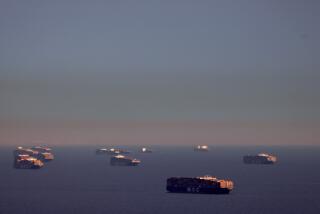Cruises: Why sailing to Hawaii may require a foreign port call
- Share via
Our cruise to Hawaii on the Celebrity Millennium began with saying goodbye to our ship docked in San Diego Harbor and taking a bus ride to Ensenada, Mexico, to meet it again.
An act of Congress made it illegal for us to board our Malta-flagged ship in the United States because our destination was another U.S. port.
The Jones Act, a 1920 maritime law, is commonly blamed for prohibiting foreign-flagged vessels from carrying passengers between two U.S. ports, without calling at a distant foreign port along the way. The restriction on transporting passengers actually originated from an 1886 law that is now called Chapter 551, Coastwise Trade of Title 46, Shipping, United States Code. Though technically inaccurate, the cruise industry refers to the law they are following as the Jones Act.
It wasn’t hard to find the right place to check in with the 91,000-ton Millennium marking the spot. We went through security and joined 2,000 other passengers in regulation purgatory.
The Millennium isn’t the only ship that faces this obstacle. Every ship that’s foreign-flagged--and many of them are--must comply with the law.
As the Millennium sailed away, passengers who would eventually be pampered by a devoted crew on a comfortable ship waited in a bare-bones structure with stark walls and hard chairs
An effort was made to make the luxury suite passengers feel special by putting them in a separate, but as it turned out, identical area. By that night these passengers would have their own butlers, but not there.
Security was strict, so once inside many did not want to leave and go through it again.
As we sat there some people did not understand why they couldn’t board the ship in San Diego. I learned later from a House aide that during each Congress the House of Representatives Committee on Transportation and Infrastructure looks into measures to change the act. So far, it remains.
Alaska cruise passengers must go through the same dance but often they don’t notice because the stop in Canada seems like part of a regular itinerary.
After climbing aboard the buses, we stopped for hours at the border. A break in the monotony came when our bus driver opened the door and a smiling man with a guitar hopped on and began to sing to us.
Then, a uniformed Mexican official who was not smiling looked around inside the bus.
The sun set as we drove through the poverty of Tijuana. It was dark as the bus took a winding road beside steep cliffs. Eventually we saw our ship off in the distance like a beacon.
Once aboard, we made our way to a late dinner in the main restaurant.
Our meal was interrupted when all passengers and crew members were required to immediately respond to the lifeboat drill. As we rushed to the back of the ship to stand at our assigned station and wait for instruction on how to put on a life jacket we felt we’d had complied with more than enough regulations for one day.
Follow us on Twitter @latimestravel and like us on Facebook
More to Read
Sign up for The Wild
We’ll help you find the best places to hike, bike and run, as well as the perfect silent spots for meditation and yoga.
You may occasionally receive promotional content from the Los Angeles Times.






